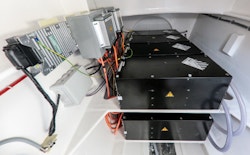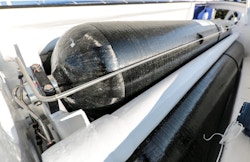Double battery and hydrogen storage of Energy Observer
Energy Observer chose complementary storage systems: short-term storage in a set of Li-Ion batteries, and eight hydrogen tanks for long-term storage.

Battery storage
The main set of batteries feed the electric motors via the 400-volt network. The capacity of 112 kWh is optimised: it’s only 2.5 times more than the type of battery used for an electric car like Renault’s Zoe!
Another set of 18 kWh batteries powers the 24-volt low-voltage network and every-day facilities on board: electronic navigation, on-board computer, lighting, comfort, security, etc. Great care was taken to make sure the two networks do not interfere with each other. For example, the engineers had to add several power converters to an even supply of electricity from the different sources (photovoltaic panels, wind turbines, etc.). Lastly, all the wiring was simplified to reduce on-line power loss, and to reduce the size of energy storage and supply systems.

Onboard batteries
Hydrogen storage
Eight tanks with a capacity of 332 L store a total of 63 kg of hydrogen, which provides the same energy as 230L of fuel. The global net energy stored is 1 MWh.
The engineers initially planned to place this bulky storage in the hulls of the catamaran, but they finally decided to distribute the tanks in external well decks on each wing.
This ensures the tanks are in a watertight environment, protected from sea spray, prevents confinement, and facilitates handling for maintenance. It did, however, require complex calculations for the weight distribution and the tank support design.

Hydrogen tanks
The only challenge the storage poses the crew is in their educational role. One of the first questions asked by visitors about safety is about how the hydrogen is stored. Because high-pressure hydrogen is an inflammable gas, the danger of storing it was an obstacle to developing its use in the past. But current storage methods have proven to be very safe, with industrial use going back over 20 years now. And hydrogen cars have also been sold for many years now, with tanks up to 700 bars.
As well as being lightweight, the hydrogen molecule is the finest that exists in nature. It can infiltrate any imperfections in materials, causing confinement loss in the long term. That is why hydrogen tanks are usually made of a shell made from carbon fibres, recognised for being lightweight and highly resistant. A second inside polymer shell, or liner, guarantees the tank is impermeable.
Hydrogen is very light, so highly resistant materials had to be used, and Energy Observer intends to prove the viability of this system in harsh conditions at sea.
Weight – a Hefty problem
The double storage of batteries and hydrogen aboard the Energy Observer demonstrates the complementarity of storage and the distribution of use.

Energy Observer
The batteries provide short term immediate power, whilst the hydrogen provides long-term autonomy. But above all, the Energy Observer demonstrates the immense advantage that hydrogen has over batteries.
The battery set weighs 1,400 kg for 112 kWh, whereas the hydrogen storage and fuel cell together weigh a total of 1,700 kg for 1,000 kWh. This means 1 kWh weighs 12.5 kg when stored in batteries, and only 1.7 kg when stored as hydrogen.
In other words, for equal weight, hydrogen storage contains 7.35 times more power than the batteries, which is a considerable advantage for mobility, whether it be on the sea, land or in the air.